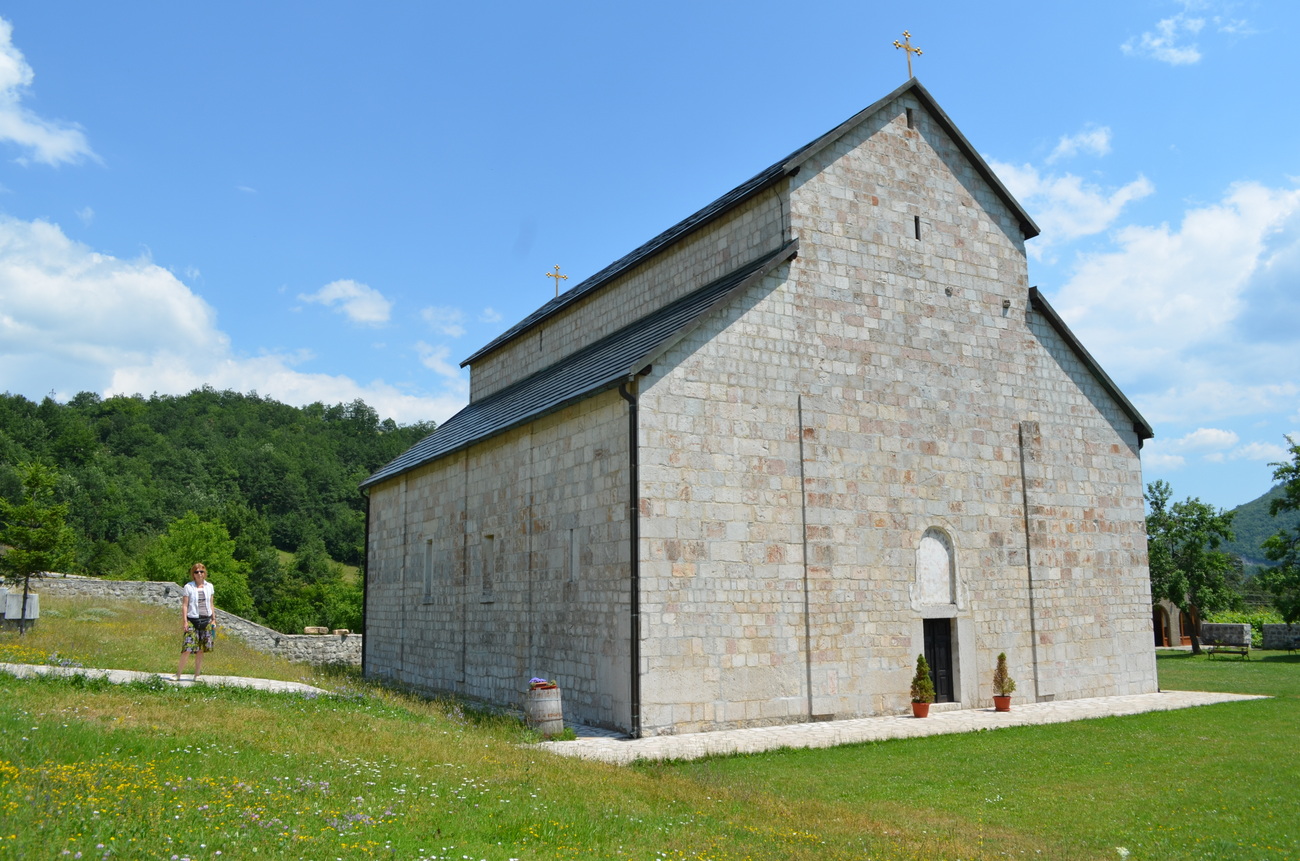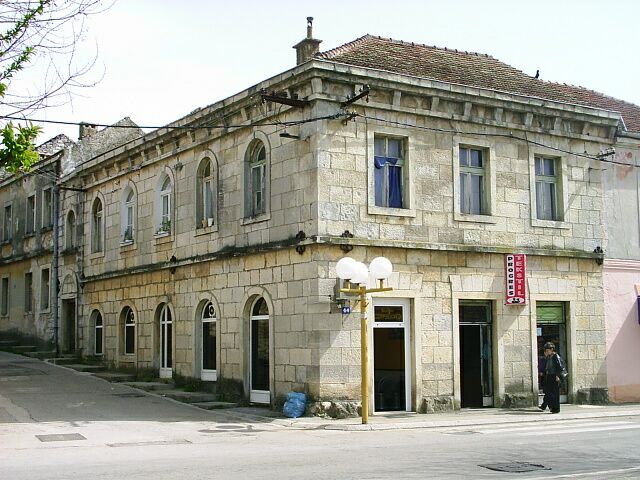|
Ruđić
In Piva, a historical tribe of Old Herzegovina (now western Montenegro), there was a brotherhood (''bratstvo'') named Ruƒëiƒá ( sr-cyr, –Ý—É—í–∏—õ). The surname was mentioned in Church Slavonic documents of the Serbian Orthodox Hilandar monastery. The Ruƒëiƒá brotherhood from Rudinice (in Plu≈æine), which later dispersed elsewhere, is one of two family trees in Piva from which many Pivan families descend from. Several families are noted in Serbian ethnographic studies as having descended from the old brotherhood of Ruƒëiƒá (''Ruƒëiƒái''). __NOTOC__ Anthropology *The Gagoviƒá brotherhood (''Gagoviƒái'') in Bezuje are according to tradition a branch of the old Ruƒëiƒá brotherhood. They were one of the oldest and most respected brotherhoods of Piva. They founded the Bezuje village which they inhabit today. Earlier, A. Luburiƒá (1930) was unsure if the Gagoviƒá family in Drobnjaci indeed descended from the Ruƒëiƒá brotherhood in Piva. *The Nikoliƒá, ƒêikanoviƒá, Gutoviƒá, and ƒêaƒçiƒ ... [...More Info...] [...Related Items...] OR: [Wikipedia] [Google] [Baidu] |
Ruđić (15th Century)
In the first half of the 15th century, several people with the surname Ruƒëiƒá ( sr-cyr, –Ý—É—í–∏—õ) were mentioned in Ragusan documents. These include, most notably: *Bogeta Ruƒëiƒá (–ë–æ–≥–µ—Ç–∞ –Ý—É—í–∏—õ; 1423) was a ''≈æupan'' (count) formerly serving Bosnian ''vojvoda'' (duke) Sandalj Hraniƒá (1370‚Äì1435), who after the Republic of Ragusa's purchase of Konavle and the decision that all inhabitants be regarded serfs led a rebellion with his brothers against Ragusa. The rebels were helped by Trebinje and other neighbours, most of all by subjects of ''vojvoda'' Radoslav Pavloviƒá (vojvoda), Radoslav Pavloviƒá. The result was an agreement that three families, the Ruƒëiƒái, Bogojeviƒái and Radinkoviƒái, "who held a good part of that area", continue their service for some time under Sandalj. *≈Ωivko Ruƒëiƒá (–ñ–∏–≤–∫–æ –Ý—É—í–∏—õ; 1422‚Äì29) was a Ragusan merchant, a companion of affluent merchant Luka Milanoviƒá (fl. 1420‚Äìd. 1429), dealing with precious metals from Bosnia and S ... [...More Info...] [...Related Items...] OR: [Wikipedia] [Google] [Baidu] |
Bajo Pivljanin
Bajo Pivljanin ( sr-cyr, Бајо Пивљанин – 7 May 1685), born Dragojlo Nikolić, was a Montenegrin and Serbian ''hajduk'' commander mostly active in the Ottoman territories of Herzegovina and southern Dalmatia. Born in Piva, at the time part of the Ottoman Empire, he was an oxen trader who allegedly left his village after experiencing Ottoman injustice. Mentioned in 1654 as a brigand during the Venetian–Ottoman war, he entered the service of the Republic of Venice in 1656. The hajduks were used to protect Venetian Dalmatia. He remained a low-rank ''hajduk'' for the following decade, participating in some notable operations such as the raid on Trebinje. Between 1665 and 1668 he quickly rose through the ranks to the level of ''harambaša'' ("bandit leader"). After the war, which ended unfavourably for the Venetians, the hajduks were moved out of their haven in the Bay of Kotor under Ottoman pressure. Between 1671 and 1684 Pivljanin, along with other hajduks and their ... [...More Info...] [...Related Items...] OR: [Wikipedia] [Google] [Baidu] |
Savatije Ljubibratić
Savatije Ljubibratić ( sr-cyr, Саватије Љубибратић; Piva, c. 1660—Topla, January, 1716) was a Serbian Orthodox bishop and metropolitan, and the caretaker of the Dragović monastery. Early life Ljubibratić was born in Piva Piva may refer to: * Piva (river), a river in Montenegro and Bosnia and Herzegovina * Piva, Montenegro, a region in Montenegro and tribe * Piva River, Bougainville, Papua New Guinea * Piva Trail, Bougainville, Papua New Guinea ** Battle for Piv ..., and belonged to the Ruđić brotherhood, at a time when the region was part of the Ottoman Empire. Ljubibratić, as many of his relatives, took monastic vows and later became a bishop. Bishop of Herzegovina Since 1687, he was a notable participant in the struggle Ottoman–Venetian Wars, against the Ottomans, in Venetian support. On 10 December 1687, he was present at Tvrdoš when the priest and vojvoda Vukašin Gavrilović with his people came from Nikšić. In 1690, he and the Tvrdoš br ... [...More Info...] [...Related Items...] OR: [Wikipedia] [Google] [Baidu] |
Piva (tribe)
Piva (Serbian Cyrillic: Пива, ) is a historical region in Montenegro, which existed as a tribe also known as Pivljani (Пивљани, ). It is situated in the northwestern highlands of Montenegro, bordering Bosnia and Herzegovina. The Piva River flows through the region. The regional center is the town of Plužine. History Ottoman period Piva was a ''nahiya'' of the Ottoman Empire, mentioned in the 1476–78 ''defter''. It was earlier mentioned in the ''Chronicle of the Priest of Duklja'' (c. 1300–10) as one of ten counties in the province of Podgorje, and in the St. Stephen Chrysobull of Serbian king Stefan Milutin (r. 1282–1321). It was part of Sanjak of Herzegovina during Ottoman rule. The Serbian Orthodox Piva Monastery has stood in Piva since the 16th century. It has produced four Patriarchs of the Serbian Orthodox Church. Modern Under Prince Nicholas I of Montenegro and the Congress of Berlin recognition, in 1878 the Piva together with the Serb Herzegovinian trib ... [...More Info...] [...Related Items...] OR: [Wikipedia] [Google] [Baidu] |
Hajduk
A hajduk ( hu, hajd√∫k, plural of ) is a type of irregular infantry found in Central and parts of Southeast Europe from the late 16th to mid 19th centuries. They have reputations ranging from bandits to freedom fighters depending on time, place, and their enemies. In the European lands of the Ottoman Empire, the term ''hajduk'' was used to describe bandits and brigands of the Balkans, while in Central Europe for the West Slavs, Hungarians, Romanians, and Germans, it was used to refer to outlaws who protected Christians against provocative actions by the Ottomans. By the 17th century they were firmly established in the Ottoman Balkans, owing to increased taxes, Christian victories against the Ottomans, and a general decline in security. Hajduk bands predominantly numbered one hundred men each, with a firm hierarchy under one leader. They targeted Ottoman representatives and rich people, mainly rich Turks, for plunder or punishment to oppressive Ottomans, or revenge or a co ... [...More Info...] [...Related Items...] OR: [Wikipedia] [Google] [Baidu] |
Slava (patron Saint Veneration)
Slava ( sr-Cyrl, –°–ª–∞–≤–∞, lit=Glory, Celebration, ) is a tradition of the ritual of glorification of one's family's patron saint, found mainly among Serbian Orthodox Christians. The family celebrates the Slava annually on the saint's feast day. In 2014 it was inscribed in UNESCO Intangible Cultural Heritage Lists of Serbia. Overview The Slava is a family's annual ceremony and veneration of their patron saint. It is a tribute to the family's first ancestor who was baptized into Christianity, with its presiding saint. The family's patron saint is passed down from father to son and only males are allowed to carry out the Slava's rituals. Upon marriage, women typically adopt the patron saint of their spouse although it is not uncommon for them to continue celebrating their native family's saint as well (in which case the secondary one is known as ''preslava''). Close friends and family gather at the home for a ritual feast. Although a religious ceremony for the purpose of saint ve ... [...More Info...] [...Related Items...] OR: [Wikipedia] [Google] [Baidu] |
Bileća
Bileća ( sr-cyrl, Билећа) is a town and municipality located in Republika Srpska, an entity of Bosnia and Herzegovina. As of 2013, the town has a population of 7,476 inhabitants, while the municipality has 10,807 inhabitants. History The first traces of civilization in Bileća date from the Neolithic period, although archaeological sites are insufficiently explored. During the Middle Ages, Bileća was located on the boundary of the župa of Vrm and the nearby Vlach necropolis was often mentioned as an important crossroad location for caravans on the way from Dubrovnik to Nikšić and Ključ, near Gacko. The town became part of the Bosnian state for the first time in 1373, after the defeat of Nikola Altomanović, but the first mention of the town under its present name is from 25 January 1387, while it appears as ''Bilechia'' in 1438. A document dated 8 September 1388 mentions that the army of the duke Vlatko Vuković defeated the Turkish army at the Battle of Bileća ... [...More Info...] [...Related Items...] OR: [Wikipedia] [Google] [Baidu] |
Old Herzegovina
Old Herzegovina ( sr, –°—Ç–∞—Ä–∞ –•–µ—Ä—Ü–µ–≥–æ–≤–∏–Ω–∞, Stara Hercegovina) is a historical region, covering the eastern parts of historical Herzegovina, outside the scope of modern Herzegovina. A large section of ''Old Herzegovina'' belongs to modern Montenegro, while a smaller section belongs to the modern Bosnia and Herzegovina and modern Serbia. All of those regions were parts of historical Herzegovina from the middle of the 15th century until 1878. In modern Montenegro, the region includes the municipal areas of Herceg Novi, Nik≈°iƒá, Pljevlja, Plu≈æine, ≈Ýavnik and ≈Ωabljak. In modern Bosnia and Herzegovina, the region includes the municipal areas of ƒåajniƒçe, Foƒça, Kalinovik and Rudo. In modern Serbia, the region includes the municipal areas of Priboj and Prijepolje. History The region known today as the ''Old Herzegovina'' was part of historical Herzegovina from the middle of 15th century up to the 1878. Initially it was part of the medieval Duchy of St. Sava ... [...More Info...] [...Related Items...] OR: [Wikipedia] [Google] [Baidu] |



